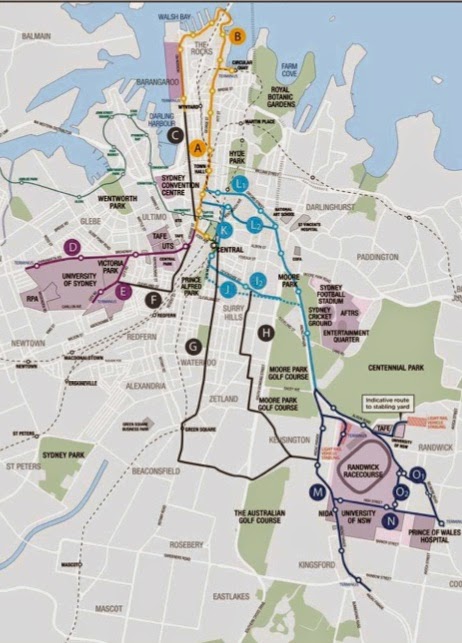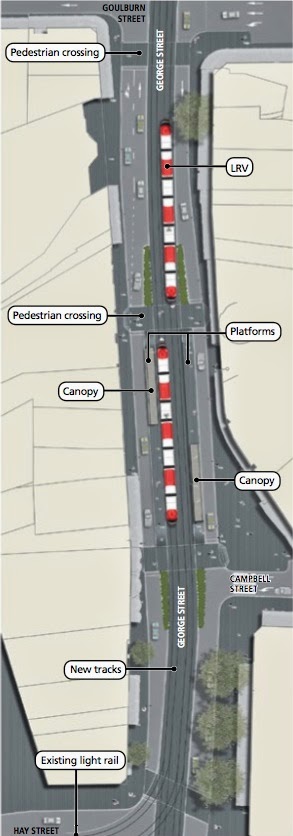 |
| Moore Park Bus Roadway exit |
- Along Flinders Street to Oxford Street and Liverpool Street to turn into Elizabeth Street
- Onto the Eastern Distributor to Bent Street to turn into Elizabeth Street southbound
- Along Fitzroy Street and Foveaux Street to Elizabeth Street
There were never trams along Foveaux and Albion Streets - they were to steep. Trams to Randwick and along Anzac Parade went along Oxford and Flinders Streets. When buses replaced trams they followed the established tram routes which were marginally shorter than the Foveaux Street route, but not shorter in time during the AM peak because of overcrowding of the right turn from Liverpool Street into Elizabeth Street northbound. A tram service in parallel with the bus road (orange line) and using the Campbell Street connection would be so superior to the Flinders Street bus services - the trams avoid the Liverpool Street turn, the congestion at Market Street, the mother of all pinch points between the Old Supreme Court Building and the St James Centre and the congestion in Phillip Street. They would all but replace the Flinders Street bus services to the northern CBD. The trams and buses would switch lanes north of South Dowling Street.
The inbound rails swing round the old Commonwealth Bank building, now garrishly painted. The remaining Flinders Street bus services could use the tram lane - there is ample space for buses to queue at the intersection to go round the corner to the stop in Oxford Street (there is no reason to allow taxis, bicyclists and motorcyclists to use this lane). With Flinders Street feeding fewer buses into the mother-of-all pinch point in Elizabeth Street more bus services would use the Foveaux Street route to Elizabeth Street. This has the advantages of relieving congestion in the Oxford Street bus route to Circular Quay at Liverpool Street and at the mother-of-all pinch point in Elizabeth Street southbound - the southbound route is along Castlereagh Street. Also, this route picks up passengers from Central Station on the northern side of Eddy Avenue reducing the need for bus services from the southeastern suburbs to the Lee Street layover (Railway Square).
The outbound tram alignment
The outbound tram rails (red line) go along Bourke Street to Albion Street with stops south of Campbell Street and north of Albion Street. Campbell Street is one-way east of Crown Street and Bourke Street is one way north of Albion Street.
Whichever route buses take to Elizabeth Street they all return to the southbound busway via a bus lane from Albion Street to Moore Park Road. The outbound trams would share this lane. The distance of the shared lane is less than the distance of shared lanes from The Strahan Street stop to the Kingsford terminus. The indicative plan of Parsons Brinckerhoff showed buses wafting into this lane at random intervals from one of the two narrow parallel general traffic lanes. I objected to this in posts on this blog and in my submission to the EIS. The dotted lines on another figure do not reveal right hand turns to Bunnerong Road will be from the shared lane and movements on this shared lane are complicated by a right turn into Gardeners Road for general traffic - vehicles that encroach onto the alignment will be run down by trams with priority signalling just like buses. "The Secretary" did not deign to comment on these matters in his Assessment.
In Flinders Street entry to the shared lane would be controlled at traffic lights and priority to buses and trams in the final section east of South Dowling Street over entry from left turning traffic would be implemented by the traffic lights at this intersection. Presumably the world famous SCATS system could coordinate the traffic lights at South Dowling Street and Moore Park Road.
The bus stop in Flinders Street between Albion and South Dowling Street would be moved to north of the pedestrian crossing on the northern side of Albion Street. There would be no tram stops between the southmost stop in Bourke Street and an ARL Central stop south of Moore Park Road.
The red line in the top figure shows the route of the outbound shared lane. Inbound trams and buses would cross Moore Park Road in parallel. Buses would separate to the right from the shared lane shortly after entering Moore Park and return to the southbound busway:
Inbound trams would cross this bus path after leaving the ARL Central stop in order to cross Moore Park Road in tandem with buses. The ARL Central stop would be located on a denuded strip of park used to access parking when events are held. No mature trees would be harmed in the alignment.
It may not be necessary to move the historic sandstone gateposts depending on how accurately bus drivers can align their buses.
 |
| Taylor Square Tram tracks |
The outbound tram alignment
The outbound tram rails (red line) go along Bourke Street to Albion Street with stops south of Campbell Street and north of Albion Street. Campbell Street is one-way east of Crown Street and Bourke Street is one way north of Albion Street.
Whichever route buses take to Elizabeth Street they all return to the southbound busway via a bus lane from Albion Street to Moore Park Road. The outbound trams would share this lane. The distance of the shared lane is less than the distance of shared lanes from The Strahan Street stop to the Kingsford terminus. The indicative plan of Parsons Brinckerhoff showed buses wafting into this lane at random intervals from one of the two narrow parallel general traffic lanes. I objected to this in posts on this blog and in my submission to the EIS. The dotted lines on another figure do not reveal right hand turns to Bunnerong Road will be from the shared lane and movements on this shared lane are complicated by a right turn into Gardeners Road for general traffic - vehicles that encroach onto the alignment will be run down by trams with priority signalling just like buses. "The Secretary" did not deign to comment on these matters in his Assessment.
In Flinders Street entry to the shared lane would be controlled at traffic lights and priority to buses and trams in the final section east of South Dowling Street over entry from left turning traffic would be implemented by the traffic lights at this intersection. Presumably the world famous SCATS system could coordinate the traffic lights at South Dowling Street and Moore Park Road.
The bus stop in Flinders Street between Albion and South Dowling Street would be moved to north of the pedestrian crossing on the northern side of Albion Street. There would be no tram stops between the southmost stop in Bourke Street and an ARL Central stop south of Moore Park Road.
The red line in the top figure shows the route of the outbound shared lane. Inbound trams and buses would cross Moore Park Road in parallel. Buses would separate to the right from the shared lane shortly after entering Moore Park and return to the southbound busway:
 |
| The return to the Moore Park busway |
 |
| No mature trees are harmed in this tram alignment |
 |
| The entry to the busway |
 |
| Doomed pedestrian/bicycle crossing |
Pedestrian Crossings
Which brings up the question of what happens to the pedestrian and bicycle crossing of the bus way on the southern side of Moore Park Road? Its fate has already been sealed by the Baird Government. Permitted pedestrian and bicycle movements have been published. To get between the stadium precinct and Surry Hills you will have to use the snail-shell spirals of the overpass or cross Moore Park Road to the east of Flinders Street and cross Flinders Street on the northern side of Albion Street.
Which brings up the question of what happens to the pedestrian and bicycle crossing of the bus way on the southern side of Moore Park Road? Its fate has already been sealed by the Baird Government. Permitted pedestrian and bicycle movements have been published. To get between the stadium precinct and Surry Hills you will have to use the snail-shell spirals of the overpass or cross Moore Park Road to the east of Flinders Street and cross Flinders Street on the northern side of Albion Street.
The busway is closed because of work on this overpass designed by TfNSW and overwhelmingly objected to, even by the North Shore Tea Party hatchet man Tony Shepherd. There are conditions that there will be no construction on the light rail project until some details of the CBD bus plan are released, that is to say until after the State Election on 28 March 2015.
The crossing at Moore Park Road would remain closed with the Flinders Street tram alignment. The only pedestrian crossing of the shared tram/bus lane would be the existing crossing on the western side of South Dowling Street. The EIS for the Eastern Distributor showed a bus stopped at Drivers Triangle. I pointed out that anyone who alighted here would have nowhere to go except to jump into the on-ramp to the the Distributor and it did not go ahead. So restricting pedestrians to this one crossing makes sense.
Thats it folks
This relatively short post has described the Flinders Street/Campbell Street tram track alignment in more detail than the George Street alignment has been described in an unbelievably voluminous Environmental Impact Statement (the public servants at Transport for NSW and their highly paid consultants have a cloying need to be acclaimed as geniuses), a never exhibited Preferred Infrastructure Report and an inane Secretary's Environmental Assessment Report (who the hell is this all powerful Secretary). The description has no deliberate contradictions; nothing has been cropped or withheld. The description is the same as outlined in a letter to the Minister more than a month before the Project was declared to be critical State Significant Infrastructure.
It ain't over until the fat turd* sinks
 |
| *Colloquially a Floatie |
The Baird government will not begin construction on the Project until after the State Election on 28 March 2015. I have no idea if contracts can be signed before then, but contracts can be broken. Neville Wran cancelled contracts to build carriageways over Darling Harbour and went on to record Wranslide election results.
The people of NSW dodged the bullet in 1976 but now we are facing a cannon.
Baird has said that if his government is elected for the first time he will consider it a mandate to sell city power poles and wires supposedly to build at any cost projects that only benefit the North Shore and have not been designed, costed, subjected to a cost-benefit study or been subject to a feasibility study. The projects exist only as a line of dots on crudely drawn maps and the dots change with every press release. Here we go again. The age of entitlement for the North Shore is just beginning.
Projects will be declared to be critical State Significant Infrastructure to avoid any independent scrutiny.
The election on 28 March 2015 will decide the future of the City of Sydney










.jpg)































